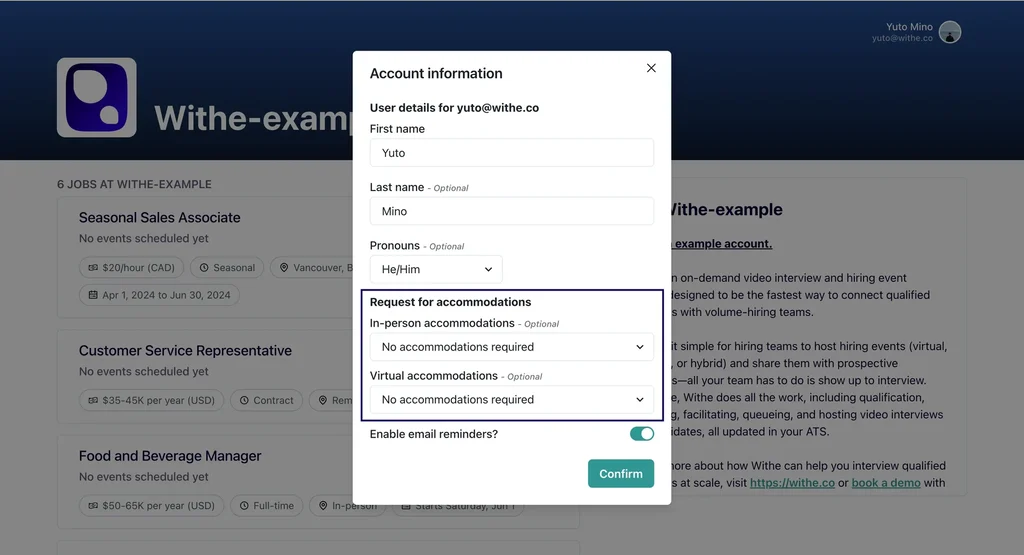by The Withe Team | February 27, 2024 | 9 min read
Contributor: Alycia Anderson, corporate DEI and accessibility consultant

The more high-quality candidates you attract and retain, the more likely you are to fill all the roles you’re trying to fill.
Ok, we realize this isn’t really a secret, but there is a part of this equation that isn’t always thought or talked about.
If your hiring process isn’t inclusive and equitable, it becomes increasingly likely that the applicant pool isn’t diverse, then your recruiters are missing out on a large number of potential qualified candidates that could become vital members of your workforce.
Inclusive hiring is critical — especially if you’re running a high-volume hiring initiative. But what does that look like in practice?
In this piece, we’re taking a closer look at what inclusive hiring is and why it matters for high-volume recruiting. We’re also sharing eight strategies for making your high-volume hiring more inclusive.
What is inclusive hiring?
Inclusive hiring is a recruitment process that aims to attract and retain candidates with as many different lived experiences as possible. When hiring is inclusive, the candidate pool is made up of people of a variety of ages, ethnicities, cultural backgrounds, disabilities, gender identities, sexual preferences, and more.
Important note: A hiring process doesn’t suddenly become inclusive because someone says it is. It requires taking intentional steps to review what barriers might exist in the existing process, consult with experts, and implement tools and practices that remove those barriers.
Why is inclusive hiring important in high-volume recruitment?
There are many reasons why inclusive hiring is important for high-volume recruitment. For starters, an inclusive hiring process directly contributes to building a diverse workforce that’s reflective of the community it serves. Diverse workforces are more creative, innovative, and dynamic — and they can do more to meet the varied needs of their customers. In addition, customers appreciate seeing their own lived experiences and community reflected back to them.
It’s also a numbers game. Let’s take disability as an example. An estimated 16% of the global population is disabled, and that number varies country to country. So, if a hiring process doesn’t include accommodations for disabled individuals, then it risks missing out on a huge number of potential candidates.
The same thing happens in your employer branding. If all people can see in your recruitment materials is white, seemingly cis-normative men, then they’re less likely to apply or accept an offer. In fact, recent data suggests that 70% of job seekers consider diversity a factor when considering a potential employer.
The hiring process is the first direct touchpoint that a candidate has with a company. If their candidate experience is inclusive, and their needs are met along the way, that will be a good indicator of what working at the company might look like. An inclusive hiring experience could be the deciding factor when it comes time to accept their offer. It can help boost your offer acceptance rate — a vitally important metric in high-volume hiring.
8 inclusive high-volume hiring practices
As you look to make your high-volume hiring process more inclusive, consider the following best practices.
1. Conduct a hiring process review
Vancouver-based Bakau Consulting describes their hiring process review as a project that helps ensure the hiring process is values-aligned and lays the foundation for cultivating trust and safer spaces for attracting and retaining talent.
Their process includes three core elements:
- An examination of the whole candidate journey from multiple angles. This is a way to identify unconscious biases and other barriers (like gendered language or subjective descriptions) that foster the status quo.
- A review of informal or unofficial procedures that may have crept into the process. For example, the hiring committee might only ever include the HR rep and the hiring manager, and there may be a need for more diverse perspectives.
- Exploring the findings and seeing where they apply across the rest of the organization.
As you conduct these reviews, it’s important to acknowledge that there are likely a lot of systemic biases at play. We spoke to Alycia Anderson, corporate DEI and accessibility consultant, for this article and she reiterated that ableism is bound to exist in the hiring process, whether you believe it or not. “Recognizing its presence and removing its existence opens vast opportunities for inclusive hiring,” she said. The same is true for all other biases that get in the way of inclusion.
2. Ensure your employer brand shows your commitment to inclusivity
Your employer brand shows candidates what your corporate culture looks like. This means that your imagery, messaging, values, and mission should reflect the diversity of your company and nod to the future desired state. Whether it’s on your career page, social media channels, networking events, or job descriptions, it’s important to use language that’s inclusive and reflective of multiple experiences.
3. Write inclusive job postings
Your job postings are more than just a place to describe the role you’re hiring for. The language you use often acts as an indicator of how inclusive your hiring is. If you use language that is classist, ableist, sexist, or homophobic, you risk alienating a number of candidates. Take time to review your job descriptions for this type of language and invite other individuals on your team to check for potential flags.
4. Give candidates every opportunity to ask for accommodations
Candidates should be able to disclose their need for an accommodation whenever it makes sense to them. This should start in the job posting. Postings should include clear language around accessibility and accommodations offered during the hiring process.
Candidates should have the space to request accommodations at every other interaction, whether that’s during the application, when signing up for a virtual hiring event, or when accepting an offer. Remember: candidates shouldn’t have to disclose a disability or an access need unless they feel they have to, but they should have every opportunity to do so once they feel it’s appropriate.

Withe makes it simple for hiring teams to facilitate accommodation requests for candidates attending virtual and in-person events.
5. Make your application process accessible to as many people as possible
“There is no such thing as inclusive hiring without actively embracing and implementing accessibility as a fundamental philosophy,” says Alycia Anderson. Every step of the hiring process should be accessible to as many people as possible. This means accounting for multiple disabilities, including mobility issues, vision loss, hearing loss, and more.
As Emily Ladau, an activist and writer in the disability space, stated in Humanizing the Hiring Process Must Include Accessibility for People Who Are Disabled: “what if someone whose strengths align perfectly with the role can’t engage with the application in the first place? Consider, for example, whether a person with a vision disability could navigate an organization’s recruitment software using a screen-reading program that converts speech to text. If the software used for hiring is inaccessible in this way, it creates a barrier to connection and the likelihood that excellent candidates won’t apply.”
6. Revisit your sourcing strategy
Where do you typically hire from? If you’re only really sourcing candidates from your employee network or a specific set of post-secondary institutions, you may be missing out on people that have different experiences to the people in your workforce. It may be time to revisit your recruiting sourcing strategy and see how you can access candidates with diverse lived experiences. This could include partnering with historically Black colleges and universities, women-led communities like Toast, or other professional organizations.
7. Invite recruiters and hiring managers to partake in unconscious bias training
Unconscious biases are an unfortunate reality of the societies we live in. Given that recruiters have a say on which candidates go through the hiring journey, their unconscious biases have the potential to be harmful against people in certain groups. Incorporate unconscious bias training into your recruiter and hiring manager training, and ensure that these are ongoing conversations for your team.
Tools like the Wheel of Privilege and Power can be a great way to start a conversation. It visually shows people where they sit in the grander scheme of things, and invites them to consider their privileges. (The closer you are to the middle, the more privileged you are.)
8. Go beyond the hiring process
If you want to hire inclusively, you need to ensure that your company has the accommodations in place to meet the different needs of your hires. This could include having gender-agnostic and accessible washrooms, ensuring that there is a clear process to safely request for accommodations, and that there is bias training for managers in charge of promoting other staff. Inclusive hiring practices should reflect an inclusive workplace culture — and vice versa.
It’s also about finding what brings everyone together, and having that be a central tenet of the organization. As Alycia Anderson said, “disability is our common ground and accessibility is what unites us.” When it comes to disability, for example, everyone will experience some form of disability at some point in their lives, implementing universal design — in your hiring process and beyond — is what ensures that everyone can show up as their best selves.
Be sure to measure your success
If you’re setting a goal to make your hiring efforts more inclusive, it’s important to measure your team’s performance against that goal. Set a benchmark that shows where you are now in terms of the diversity of your candidate pools and hires. Establish a target for what you want your next rounds of hiring to look like, and refine your process using the steps we outlined above.
Contributor Bios
The Withe Team

Meet the team behind the revolutionary on-demand video interview software that connects great companies with top talent. Their user-friendly solution streamlines the hiring process and helps people find the right opportunities. With a customer-centric approach, this team of experts is dedicated to helping you find the perfect match.
Alycia Anderson

Alycia Anderson is a TEDx motivational speaker, corporate Diversity, Equity, Inclusion & Accessibility consultant, advocate, and the founder & CEO of The Alycia Anderson Company, LLC. She shines light on how our diversities are core to the qualities that make each of us uniquely qualified and able in life.